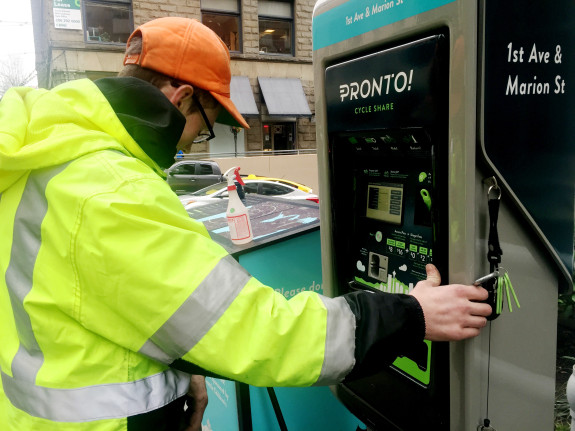
When you go to check out a Pronto Cycle Share bike, you probably only see the bikes and docks. You beep a bike with your key fob or swipe your credit card at a kiosk and a bike unlocks. You ride it to the station closest to your destination, push it into the dock and “beep,” it locks and disappears back into the bike share system.
You walk away as though you didn’t ride a bike at all. You don’t need to return it to where you started, and you don’t need to worry about it being stolen. You don’t need to fix a flat tire or take it in for a tune-up. When you decide you want to bike again, a working bike will be waiting for you.
But this doesn’t happen by magic. It takes a team of smart people working behind the scenes for system operator Motivate to keep Pronto so safe and easy. As the Seattle City Council prepares to vote Monday on whether to buy the system, the debate has largely ignored the value of the trained and inventive staff working every day to get better and better at running a bike share system uniquely designed for Seattle.
The Council will vote during their 2 p.m. meeting Monday, and you can testify to support the buyout plan at the start of the meeting (sign up before the start of the meeting). Under the plan, the City would buy the system, and Motivate would continue operating the system while the city requests bids for an expansion (presumably, Motivate will be among the companies bidding on the contract).
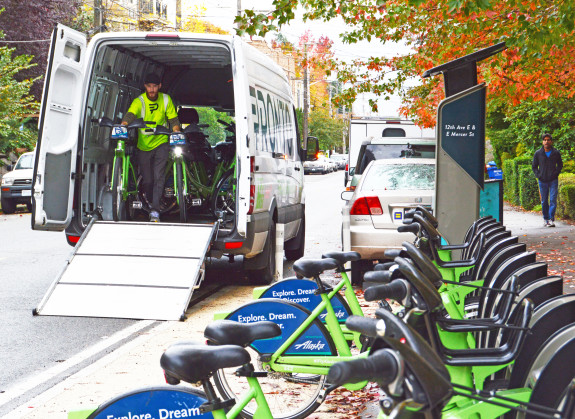
It’s hard to put a dollar amount on the value of having a fully functional system up and running because there are so many small-but-vital pieces that make it happen. It’s easy to say that the docks and bikes are worth so many dollars each, but what is the value of having a dedicated staff who have spent more than 17 months learning how it all works and how to fix it?
Puget Sound Bike Share’s assets are valued at $2.1 million, and the city would get it all for $1.4 million (bringing the city’s total bike share assets to 3.1 million). That’s a pretty good deal. But even that deal downplays the real life value of having a system already operational, with an existing user, sponsor and partner base.
It’s a mistake for the City Council’s cost-benefit analysis to ignore these elements. Because if you spend a day with Pronto staff, you’ll be amazed how many small problems they have figured out and how efficiently they run the system. You’ll see that the deal the city is getting on this system is a steal.
There’s the big, obvious stuff like servicing bikes (they check every single bike at least once every month), rebalancing bikes to prevent full or empty stations, cleaning and distributing helmets (as required due to King County’s rare all-ages helmet law), and maintaining dock functionality.
But there’s also the little things, like figuring out how to prevent mice from getting inside the station kiosks (a problem you wouldn’t think about until it happens) or learning which pedals and saddles last the longest through persistent rain and cold. They’ve found small defects in the equipment and worked with the manufacturers to invent solutions (a big dock upgrade is coming soon to help fix the “dead” docks problem). At this point they’ve got daily bike flows down to such an art that they can “prebalance” bikes well enough some mornings that they only need to do a limited number of rebalancing runs during the day.
“A lot of good things have come from this already, and we’re just over a year in,” said Pronto’s Lead Technician Grant Kahl as we crawled through downtown traffic in the Pronto service van to do some maintenance work on the station at 1st and Marion. “I’m proud of the work we’ve done.”
Before getting temporary work at Pronto, Kahl delivered for Jimmy John’s downtown. He was hired to help with the initial installation of the stations, but he managed to make himself helpful enough that they hired him on. He has been dedicated and worked his way up to the Lead Technician job.
“It’s kind of developed me as a person,” said Kahl, who puts a lot of personal pride in how much he has learned and how well the team keeps up on maintenance and basic system functionality work that users may never even think about.
I asked him about the irony that he has to spend so much time in a car in order to help others bike.
“I like driving,” he said, “but it seems like I go a lot further faster on my bike…You don’t have to pay for parking and you don’t have to sit through traffic on Mercer.”
Not only has Pronto improved people’s ability to get around traffic congestion, but Pronto staff have learned a lot in a short period of time.
“We have a pretty good knowledge base,” he said. “It would be a shame for all that to go down the drain.”
In fact, Kahl believes so much in the value of the work Pronto does, that he keeps telling people there’s no way the city will close it down.
“I feel like at this point we’re part of the community,” he said. I hope he’s right.
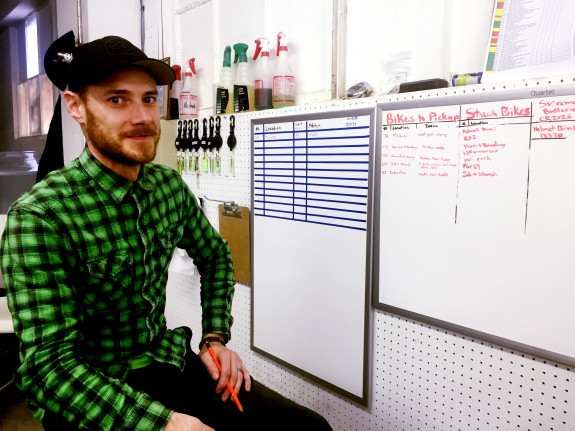
If year one was all about learning how to make the system run efficiently, year two should be about optimizing the system we have and focusing on how the system can grow.
The plan was to expand a little in 2015, but then the city announced their intention to buy the system and dramatically expand it using federal grant funds (they did not win the competitive grant). Work to gather more sponsors to fuel that expansion was put on hold and the system’s non-profit owner Puget Sound Bike Share worked instead on transferring ownership to the city.
But that buyout got delayed for months, then PSBS staff quit as the non-profit started disbanding. Now the Council’s decision comes with a deadline looming before PSBS defaults on a loan and the system closes down. You can read more about how Pronto got into this financial trouble in our previous story.
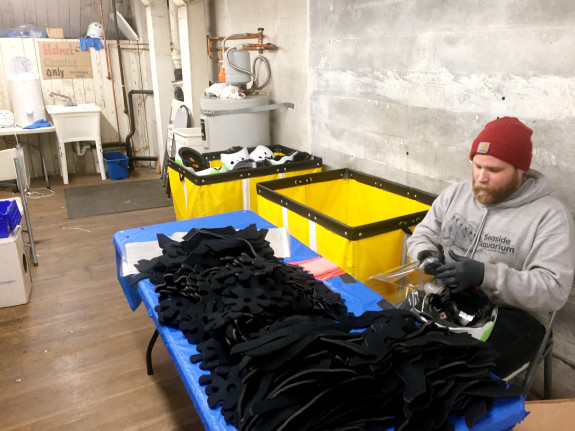
The Pronto staff has made it through the hard work of getting the system up, learning how to keep it running, and forming valuable partnerships with employers, hotels, building managers and businesses that will only grow as the system matures.
To date, Pronto has partnered with over 40 companies and organizations on campaigns and promotions. 55 employers have corporate memberships in which they provide staff discounted or free memberships (1,400 members have signed up through their employers).
“It would take a lot of time and work to restore [these relationships], especially their trust,” said Marketing Manager Shae Healey.
While all this uncertainty with the city’s buyout has made it difficult to secure sponsors and partners, it has also made it harder to get new annual members or to convince expiring members to renew. After all, few people are going to pay for a year if they aren’t sure it will be in service that long.
SDOT and City Council analysis of the Pronto budget has shown that a city-owned Pronto would run about $115,000 over budget annually assuming no new stations and no growth in memberships, rides, sponsorships and other forms of income. But of course those revenue sources will all grow. It’s not an insurmountable budget gap.
Revenue will grow as more people discover the system, more employers join the corporate membership program, and more sponsors sign on. And as we’ve reported previously, revenue could become a lot healthier with more stations reaching more destinations.
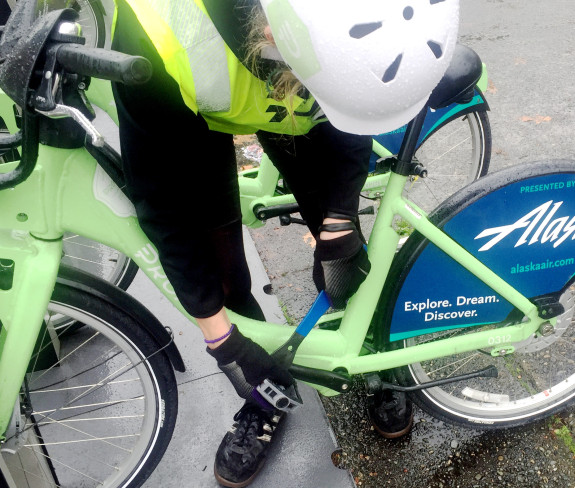
Pronto General Manager Demi Allen is excited about the future of bike share in Seattle despite the dire headlines. Analysis of operations data (one of many jobs Danielle Schrimmer handles) and user surveys is already helping them improve efficiency and outreach.
They tried 14 promotional campaigns in year one, giving them insight into where to focus efforts this year (Pronto Week in late April was a smash hit, as was the #ProntoGlam unicorn bike).
Their efforts are mostly focused on “communicating how Pronto can fit into your life,” said Allen (he likes to envision bike share as a “human-powered subway”).
“It’s not a single fix for transportation needs,” said Healey, but bike share works in balance with other options.
As time goes on, more and more people will become familiar with the system and make it part of their transportation mix. And with a year of experience and user building under their belts, Pronto is poised to flourish.
City Council, don’t throw this all away at the first sign of trouble, much of which the city itself caused. We’ve got a great system ready to keep getting better.
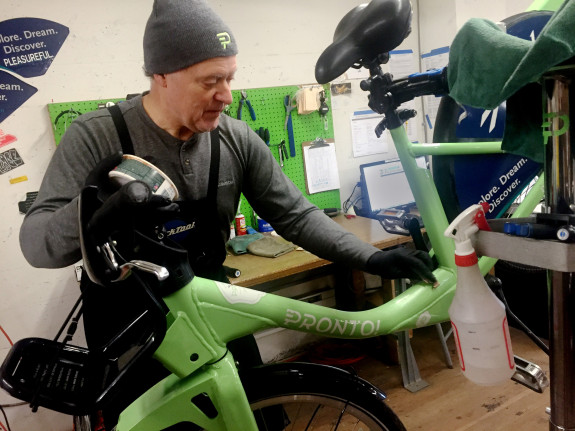








Comments
24 responses to “Behind the scenes of Pronto with the experts who make it all work”
What do they do with the helmets they retire? I don’t need a new fancy $50+ helmet, and would happily buy a used helmet that’s only seen 15 rides and has been disinfected. I suspect I’m not alone.
Also, I could think of numerous places where they could be donated to for individuals who couldn’t otherwise afford helmets, or non-profits could use them for events.
I heard once it was illegal to sell used helmets. Perhaps the bike shop staff who said that was conflating legality with liability concerns, though. Anyone know?
Oops! I had that number wrong. It’s 50 uses, not 15. I corrected the story.
Cool post but these are garbage lies that you should really stop spewing.
“Puget Sound Bike Share’s assets are valued at $2.1 million, and the city would get it all for $1.4 million (bringing the city’s total bike share assets to 3.1 million). ”
They are not worth $2.1 million and on sale for $1.4 million. Buying a liability has no value at best. Otherwise this political process would not be necessary.
Debt is a liability. A fully functioning bike share system is an asset to an urban transportation system. While it could be functioning much better, the truth is that it functions now and people rely upon it.
great post, I hope the city makes the investment, integrates it into ORCA, etc.
Great story. Thank’s for covering the folks who keep pronto running (even more admirably given the instabilty they must be feeling).
I’m interested to read about the upcoming upgrade to fix the ‘dead dock’ issue. There were a lot of glitches when the system rolled out (slipping gears, empty docks that wouldn’t Llow you to return a bike, etc.) but I’ve noticed the bikes and stations subtley becoming better and better. The dead docks are the last glitch I still see, but they’ve become a lot less common.
It’s too bad the political side has detracted from the system’s growth, because the pronto system really is an asset that it would terrible to lose. The city should buy pronto and expand it tenfold. We need dozens more stations, and the system will be wildly popular when we have them.
This statement begs a more detailed discussion: “Pronto Week in late April was a smash hit …”
While usage was up in late April, it was due entirely to one factor: The American Planning Association conference rom April 18-21, 2015.
If you look carefully at the data you will see that that those four days saw a huge spike in trips by short term pass holders. Fully 67% of trips those four days were tourist trips and the stations they cycled to and from were primarily located near their hotels and tourist spots downtown and at the waterfront.
These four days saw the highest four-consecutive-day usage of the entire year — definitely successful compared to much of the rest of the year. Immediately after the conference, however, usage returned to it’s previous lackadaisical level. I wonder what lesson Pronto planners learned from that?
I consider myself an experimentalist who constructs theories only after looking at the data. Based on the available data I would theorize that Pronto could be more successful focusing it’s attention on the tourist market. Here are two data-driven reasons:
1) The APA conference, along with Pier 69 round trips demonstrate an unmet need for downtown bicycle access for tourists.
2) Bikeshare data in Seattle and across the nation show that tourist trip usage is more lucrative than annual pass holder usage. I say: “let tourists pay for the system”.
So lets build a system that intentionally caters to tourists — both out-of-town and cross-town. They can pay for a good chunk of it and Seattleites get to benefit. I would also advocate for a focus on bikeshare as a transit extender by locating stations at and near light rail stations. (Also a huge benefit for tourists.)
My guess is that a focus on tourism and extending light rail is more likely to be successful in Seattle than the current, poorly articulated focus. (What problem is Pronto currently trying to solve?)
Regardless of what the city decides to do with Pronto, I hope the people involved will make decisions based on readily available data rather than anecdotes and received wisdom.
You can explore the data for yourself at: http://mazamascience.com/ProntoDataChallenge
PS__ Tourists also like to ride the Burke Gilman. ;-)
Thanks for this analysis.
One major piece about Pronto Week is that it is essentially a spring “relaunch” aimed at getting people to buy annual memberships ahead of the summer months. So part of what made it a success for Pronto was membership sales, which may not directly result in immediate surges in trips.
However, I don’t have data handy to make this point. This is just how it was explained in an interview with Pronto.
In other words, the first step is to get Pronto keys on people’s key rings. Then you have all summer for people to figure out how it works for them. Everybody’s bike share use is going to be a little bit different.
Tourists are certainly over-represented in ridership, particularly in newer and smaller systems like Pronto. But commuting and extending our investment in better buses and light rail is a key feature of bike share.
http://mobilitylab.org/2016/01/06/bikeshare-ridership-tracks-metro/
Fortunately a larger system can serve a variety of uses. Both commuters and visitors would go to Fremont, for example, and a Fremont expansion allows trips along the Burke-Gilman trail to Link or for recreation.
I LOVE the map at that link! It shows incredibly well the ideal use case for bikeshare — connecting neighborhoods to metro stations along flat, safe bike routes.
One week in which a great concentration of urban planners descended upon Seattle is an anecodote found in the data, not a trend that can clearly be extrapolated.
The received wisdom is that bike share truly flourishes in places where a lot of people walk a lot of different places at a lot of different times for a lot of different reasons, but might want a bike to get around a bit faster. Not a single “articulated” focus, but a complement for destination-rich urbanism. Consider Seattle’s downtown retail core: some of the busiest sidewalks in the city, over a wide swath of the week. If you look at a crowd of people walking one direction on any particular block you can’t guess where they’re going within the next couple blocks. There’s nothing spectacular about downtown Seattle’s retail core, it’s just a lot of stores ranging from overpriced-and-fancy to somewhat-overpriced-and-dingy, some hotels and offices, some homes, and great transit access. That received wisdom is based on a lot of data from a lot of cities. It’s hard to swallow in Seattle because we don’t have a lot of these places.
If you want a system that radiates from mass transit… maybe wait a few years? The Link stations near 45th and 65th will be more natural points to catch people than Montlake/Pacific — this is particularly obvious if you’ve followed the bus restructure, but experience on the Burke illuminates the issue, too. People talk about getting downtown via bike-and-train from as far west as Fremont, when it would be obviously faster and less complicated to just ride straight downtown, or even to catch a direct local bus much of the day! Montlake/Pacific, though it’s along the Burke, is a forgotten corner of the city and out-of-direction for most connecting trips except those from the northeast, where the Burke runs along hillsides, some distance from where people actually live (meaning people will want wheels to get to the Burke, not just to ride along it). The next couple stations north will be in the middle of busier and more interesting places. Making these areas, and the retail core, and Capitol Hill, thoroughly bikeable will be a challenge; but far less so than making the new Rainier Vista an interesting multi-destination pedestrian hub, which would contradict every law of urban geometry.
Al,
I agree with everything you say but I feel some important parts of the story are still missing: hills and safe routes.
If downtown Seattle had a grid of flat, safe routes for cycling, bikeshare would no doubt be a big hit already. Unfortunately, Seattle is the only city attempting bikeshare with downtown streets this steep, this full of traffic and this interrupted by construction. I agree that Capitol Hill is an ideal place for bikeshare right now. But Ballard might actually become a destination-rich urban village in less time than it takes for us to sort out safe bike routes in the downtown core.
The available data from our Pronto make a few things completely clear:
* on average, people don’t ride Pronto bikes uphill
* some stations are MUCH less popular than others
I wish someone would do a station-by-station analysis to better understand individual station placement and theorize about why some stations are popular and some are not. Based on that theory, we should have a plan in place for an annual reshuffle where we move the most unpopular stations (<5 visits per day).
Think of each station as part of a franchise. Businesses open and close new stores all the time based on profitability. Pronto should do the same based on usage. The customer is always right after all.
“Unfortunately, Seattle is the only city attempting bikeshare with downtown streets this steep, this full of traffic and this interrupted by construction.”
This isn’t true. San Francisco has Bay Area Bike Share:
https://www.sfmta.com/projects-planning/projects/bike-sharing
SF is hillier than Seattle, with worse traffic and similarly poor bike infrastructure. They’re currently in the process of expanding it. In the past year the system has seen 314,000 trips – at 700 bikes, that’s 1.2 trips per bike per day. That’s also w/ a weird satellite system (SF downtown only has 350 bikes).
As far as doing a station-by-station analysis, are you sure that hasn’t been done? https://www.prontocycleshare.com/datachallenge
Ballard isn’t real big, and Fremont is smaller yet, but I can buy the idea of a Westlake-Fremont-Ballard extension from SLU, with station locations in the right places. But that’s moving the goalposts — you were talking up bike share specifically for flat connections to transit, which isn’t what this idea is about at all.
The downtown retail core, as opposed to the office core south of there, has a bit of a plateau to it. There’s another plateau covering parts of Pioneer Square and the International District. These areas are each bigger, denser, busier, and much more popular by mass transit than the urban core of Ballard. They’re as close to eachother as Ballard is to Fremont, and though the office core is steep east-west, the avenues follow reasonable routes north-south; and it’s not like the office core is empty, it’s just steep east-west. The other areas adjacent are bigger and denser, too, though there are hills: Belltown and past that Seattle Center, SLU, First Hill, Capitol Hill. And, accordingly, these (along with the U District) are the parts of town where you see the most people walking.
None of these areas are perfect textbook urbanism with blockbuster bike-share potential. Between the natural challenges, man-made flaws, and yet-incomplete construction projects, there’s a lot to worry about. Some of those man-made flaws will be significantly diminished over the next decade, and greater-downtown will become a lot more cohesive (though we’ll have to work hard to rein in cars in some areas)! Anyway, it’s hard to argue with widespread foot traffic as a major consideration for bike-share potential. Call Pronto crazy in a lot of ways, but starting centered around downtown was fundamentally the right idea.
I just took a look at the current station density and terrain for the bikeshare system in San Francisco. It looks like the network of stations in downtown SF very highly concentrated on relatively flat streets in the downtown core. By comparison, the Pronto network is very diffuse — spread out over an area many times larger that also includes some serious elevation changes.
I could get behind a network that was focused on downtown if it were truly focused on downtown. The current network is spread out all over the place with no clearly defined, achievable goal. Although I have a self-serving preference for bikeshare as a transit extender I mostly just want it to be successful in the early stages so that it can eventually expand.
The main thing I would advocate for is a willingness to redesign the station layout and a clear statement about what problem the initial (redesigned) layout of stations is trying to solve along with some station effectiveness metrics to assess whether any given station is meeting expectations.
In the interest of transparency, we need to measure and report on the effectiveness of individual stations and of the system as a whole.
But a desire for success and a desire to solve a clearly designed problem may be deeply in conflict.
Successful bike-share systems the world over build on success. Success measured in feet on the ground. Where we perceive problems, like last-mile transit access, is usually where feet on the ground are missing. Can bike-share cause such a seismic shift? Show me the precedent. Seattle doesn’t bring much in the way of unique opportunity, but it brings a lot of challenges.
It’s not that bike-share has never solved anyone’s last-mile transit access problems. But where it solves many people’s last-mile transit access problems, it’s usually over a last mile that’s pretty active already. Otherwise the people living there have probably already said, as Eben Weiss puts it, “Fuck it, I’m leasing a Hyundai.”
[…] the Seattle Bike Blog, Tom Fucoloro detailed the work the Pronto staff does and made a convincing case that in them the city is getting a gaining an asset beyond the $2.1 […]
[…] ← Behind the scenes of Pronto with the experts who make it all work […]
[…] peeps: A behind-the-scenes look at how the experts at Pronto run their […]
[…] town and connecting to transit. Though it seems like a simple idea on its face, Pronto is actually a pretty impressive and intricate operation that can be a deceptively powerful transportation […]
Nothing sure of propaganda for a failed program. Pronto wastes space on city streets and is huge was of money. Your “analysis” is based on fair tales and unicorns with the belief that saying things make them true. The purchase of Pronto is a waste of city money and they program as it stands is a joke. Anyone who is a member of Pronto is wasting there money. Just buy your own bike if you want a biking lifestyle. Pronto is not the future!
The writer of this blog is clearly biased, has no analytical skills, has no journalistic belief in truth or fact, and is most likely being paid to promote the sales of Pronto.